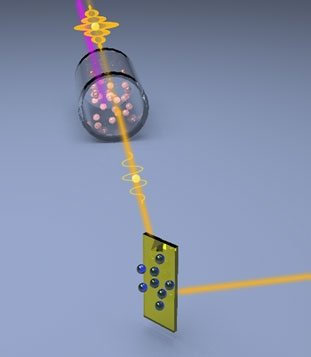| Feb 14, 2022 |
Squeezing the noise out of microscopes with quantum light
(Nanowerk News) Lasers are often used to look at objects in microscopes. But even the best laser has “quantum noise” that makes a picture blurry and hides the details. This in turn results in measurements that are less precise than scientists need.
|
|
Researchers have designed a new type of microscope that uses squeezed light to reduce measurement uncertainty. Unlike today’s classical microscopes, this quantum microscope requires quantum theory to describe its sensitivity (Physical Review Letters, "Truncated Nonlinear Interferometry for Quantum-Enhanced Atomic Force Microscopy").
|
|
The microscope uses special “nonlinear” amplifiers to generate a quantum light source known as squeezed light. This approach enabled a 50 percent improvement in the sensitivity of a specific scientific measurement.
|
 |
| A quantum light approach for microscopy enables scientists to measure signals with much-improved sensitivity. (Image: Oak Ridge National Laboratory)
|
|
Scientists routinely use devices called atomic force microscopes to measure the properties of materials at the nanoscale. This novel method reduced the degree of uncertainty in atomic force microscopy. This will result in new understanding of the properties of materials.
|
|
With enough squeezing, this approach can unveil fast electronic interactions that cannot be measured with a classical microscope. In addition, the squeezed light heats the microscope much less than a laser would.
|
|
This is particularly important for microscopes operated at very low temperatures or for materials that are sensitive to changes in temperature. Microscopes with reduced uncertainty, higher speeds, and lower temperatures will open the door to new studies of quantum materials and quantum devices.
|
|
Quantum microscopy relies on extremely delicate control of light waves. However, its sensitivity is typically limited by optical losses. In this research, scientists circumvented the problem with a special type of entangled light called “squeezed light.” In this case, squeezing means that the intensities of the light beams are correlated with each other at the quantum level. Because of this, noise in the measurements is reduced, thus providing a higher signal to noise ratio.
|
|
The research performed here integrated an atomic force microscope microcantilever into a low-loss nonlinear interferometer that generated squeezing with a four-wave mixing process. The researchers reduced measurement uncertainty with minimal heating of the cantilever by taking advantage of low-power squeezed light and high-power reference signals (the latter never interact with the microcantilever).
|
|
By increasing the power in the reference signals and increasing the squeezing at the same time, it is now possible to achieve a substantial improvement in microscope sensitivity.
|

